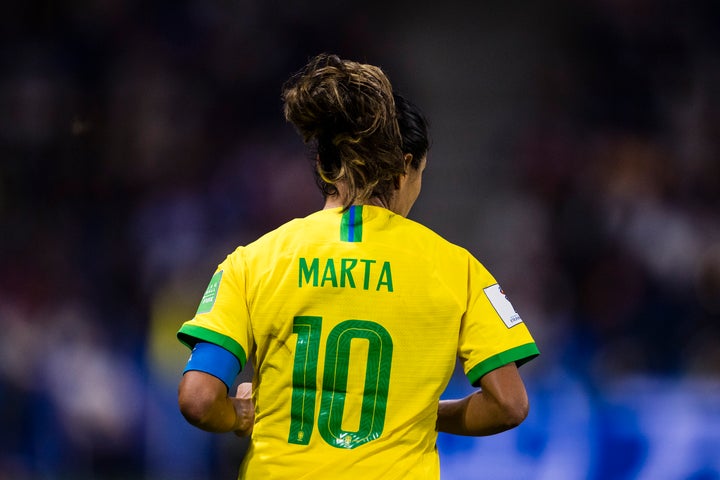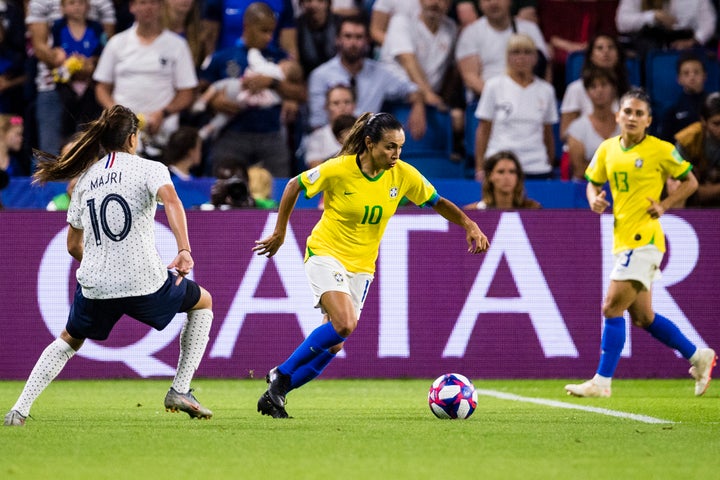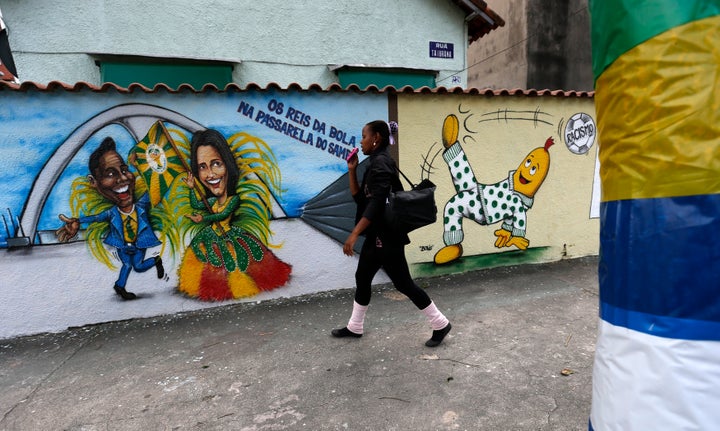
Fans of Brazil have spent the last decade-plus becoming accustomed to the sort of heartbreak so long relegated to those fans from lesser footballing nations.
But Sunday’s 2-1 loss to France in the Women’s World Cup round of 16 brought a special dose of disappointment: Far from South America, on a field in Le Havre, France, the greatest woman to ever play for Brazil ― and probably the greatest woman to ever play football, period ― might have donned the country’s famous yellow shirt for the final time, at least at a World Cup.
All careers must end, even those of the stars who seem immortal at their peak. It happened to Pelé and Zidane, Ronaldo and Cruyff. Most of them are revered for what they did as they did it.
Marta, by contrast, may go down as the most underappreciated superstar in the history of this sport.
It wasn’t for a lack of effort or accomplishment. Marta is a six-time world player of the year and Brazil’s all-time leading scorer. She hauled Brazil to the World Cup final in 2007; this year, at 33, she scored twice, and her 17 career World Cup goals are more than any other man or woman has ever scored at the tournament.
Rather, it’s because of the sheer fact that she was a woman, and in her country and beyond, women’s football still suffers from a lack of investment, a lack of attention and a lack of care.
“Marta may go down as the most underappreciated superstar in the history of this sport.”
You can trace the brief modern history of women’s football on the canvass that is Marta’s career. She was born in 1986, mere months before Brazil’s women’s national team played its first competitive match. Five years prior, Brazil had lifted its ban on women’s participation in organised football; five years later, FIFA would stage the first Women’s World Cup.
Marta made her pro debut at age 14 for a team that wasn’t quite pro, then spent the next 20 years traversing the world in search of the sort of stability that is only now becoming conceivable for women’s football’s biggest stars. She played in two American leagues that don’t exist anymore, and for three teams that don’t either. She has found a reliable home in the National Women’s Football League, the first U.S. pro league to make it past its third birthday, but she still makes a fraction of what far less accomplished men do.
She played this year in a World Cup that is a testament to the rapid and inevitable growth of women’s football, but she did so for a country that continues to resist that progress at every turn. She has revolutionised the sport like no woman before her, and yet she is evidence of how limited an impact any one player or team can have on the future of women’s football if the powers that be in countries like Brazil and in a world dominated by FIFA won’t push forward.
Marta is women’s football’s greatest story, and one of its most tragic, too.

Marta burst onto the World Cup scene in 2007, part of a golden generation that could have turned Brazil into the sort of superpower it has been for decades in the men’s game. She won the Golden Boot as the tournament’s top scorer and the Golden Ball as its best player. At just 21, she carried Brazil to the World Cup final and torched the sport’s biggest, baddest team — the United States — in the process.
It was around that time that she earned the nickname “Pelé in skirts,” a moniker often attributed to O Rei himself, though the sourcing is dubious. On the pitch, it fit, the reference to a garment women don’t wear during football matches notwithstanding. Women’s World Cup history had not yet produced a player who combined sheer athleticism with technical grace so completely. While some could match her lightning-quick speed, Marta added a technical acumen no one else could, challenging the existing idea of what women’s football could look like, as SB Nation’s Kim McCauley wrote in a glowing profile of her before this year’s World Cup.
Marta dazzled opponents with the sort of flicks and tricks and audacity that stereotypically come to mind when one thinks of Brazilian football, moving the ball from one spot to another in ways defenders couldn’t anticipate because they’d never had to. It wasn’t just for show. Marta has netted a couple hundred goals over her career, including 111 for Brazil. None were better, perhaps, than the last one against the United States in the 2007 semifinal.

Marta’s ability to destroy defenders left an indelible mark on the shape and feel of her sport. In 2007, her utter annihilation of the U.S. Women’s National Team, as McCauley details, altered the future of football. It forced the world’s preeminent power, and thus everyone else, to overhaul their approach to the game. It wasn’t all that different from the way Pelé, Garrincha, and a host of Brazilian immortals brought o jogo bonito — the beautiful game — to the world in the 1950s and ’60s, and changed football forever.
Off the pitch, though, the comparison between Marta and Pelé breaks down. Pelé debuted for Brazil in 1957, at a time when the country’s top domestic clubs were among the best in the world and the national team was on the verge of becoming the best in history. He helped Brazil win World Cups in 1958, 1962 and 1970. That run of success wasn’t an accident: It resulted not just from Brazilian players’ innate talent but Brazil’s active efforts to produce, nurture and promote it. Brazil won because Brazil ― all of Brazil, and most importantly, the Brazilians in charge of football ― wanted to.
Pelé’s success, and Brazil’s, turned him into a global superstar, one of the world’s highest-paid athletes and, even in countries where football proved an afterthought, an icon. “My name is Ronald Reagan, I’m the President of the United States of America,” our 40th president reportedly told him during a White House visit in the 1980s. “But you don’t need to introduce yourself, because everyone knows who Pelé is.”
Marta, by comparison, has toiled in relative obscurity, lesser known to most everyone who isn’t a women’s football devotee than she should be. Casual fans may know her name, but it’s hard to imagine that they understand her impact on the sport or recognize her rightful place among the legends of football lore, Brazilian or otherwise.
The sort of ultimate World Cup success that guarantees immortality in Brazil has eluded Marta and this generation of Brazilian talent. But that’s a convenient way to explain her obscurity — because that kind of success also has a price, and when it comes to female athletes, Brazil’s football federation has never been willing to pay it.
The Brazilian Football Confederation, known as the CBF in Portuguese, responded to the 2007 final not by investing in its women’s team but by letting it languish.
“This is what I ask of the girls. There's not going to be a Marta forever. The women’s game depends on you to survive.”
- Marta
Twelve years later, as Latin American football historian Brenda Elsey detailed before the World Cup, Brazil still has no professional women’s football league in which players can make a living wage. It spends almost no money on its national team. It barely acknowledges its women except to talk about them as sex objects. Brazil’s modest success obscures the fact that, as Elsey wrote, “there is perhaps nowhere in the Americas that rivals Brazil in its draconian treatment of women’s football.”
The Brazilian national team, as a result, has fallen backward as other nations have surpassed it. Brazil reached the quarterfinals in 2011 but hasn’t moved past the round of 16 since. Some of that is down to bad luck and bad draws, but it’s also hard to ignore that France and the Netherlands, two teams that didn’t qualify for the World Cup in 2007, are today the sort of contenders Brazil could have been with a more attentive and invested federation.
Marta could only change the game so much. The burden to do the rest falls on the CBF and FIFA, the governing body that continues to shortchange the women’s game even as it sells itself as an agent of change.
That they haven’t, especially in Brazil, is evidence enough of the maddening levels of sexism, incompetence and corruption that run throughout FIFA and many of its federations. Marta and her teammates — from veterans Formiga, Bárbara and Cristiane down to emerging stars like Debinha and Ludmila, a stalwart for Spanish champion Atlético Madrid — are proof of the talent that exists in Brazil, and there’s an obvious and growing interest in the game among Brazilian fans. Even with games happening primarily during the daytime, and even while it’s hosting the men’s Copa América tournament, Brazil set television viewership records throughout this World Cup, with nearly 20 million people tuning in to its matches.
As Elsey noted, there’s pressure to invest from above — the South American federation has implemented rules promoting the development of women’s club teams — and below, from grassroots organizations developing the game at the youth level. The ingredients are all there. But the CBF has taken only the smallest steps toward improving the women’s game.

Marta has not said whether this was her last World Cup, though her teammates have admitted that they know the end is nigh.
Whatever the case, she turned her two weeks in France into a crusade for the equality that still eludes her and women worldwide. After Brazil beat Jamaica, Marta sought out Cedella Marley, the daughter of Bob Marley and the Reggae Girlz’ biggest benefactor, to urge her to keep up her fight for women’s football on the island.
Against Australia, she celebrated a goal by pointing to a women’s equality flag on her boots, a gesture that required that she forgo a sponsorship deal to pull off. She wore bright red lipstick during matches against Italy and France as a symbol of her commitment to the game, and said she and her teammates were fighting “to represent women.” After the loss that might end her World Cup career, she urged girls back home to keep fighting for their future.
“This is what I ask of the girls. There’s not going to be a Formiga forever. There’s not going to be a Marta forever. There’s not going to be a Cristiane,” Marta said, referring to two of her fellow Brazilian legends. “The women’s game depends on you to survive. So think about that. Value it more. Cry in the beginning so you can smile in the end.”
In a just world, Marta would take her deserved place among the many mononymous stars of Brazil’s past, in a pantheon next to Pelé and Garrincha, Romário and Ronaldo, Ronaldinho and the like. Instead, the greatest player in the history of women’s football ended this World Cup begging girls to ensure the survival of the game she helped build — all because, and only because, the people in charge still refuse to build it for them.